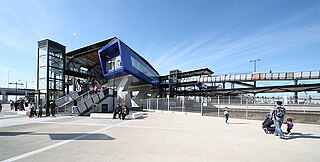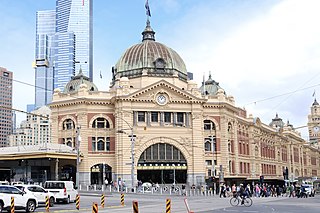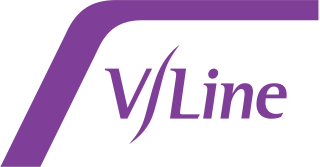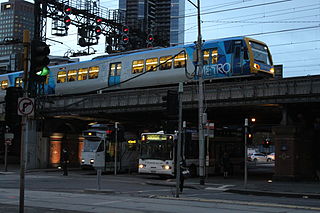
Proposals for expansion of the Melbourne rail network are commonly presented by political parties, government agencies, industry organisations and public transport advocacy groups. The extensions proposed take a variety of forms: electrification of existing routes to incorporate them into the suburban rail system; reconstruction of former passenger rail lines along pre-existing easements; entirely new routes intended to serve new areas with heavy rail or provide alternative routes in congested areas; or track amplification along existing routes to provide segregation of services. Other proposals are for the construction of new or relocated stations on existing lines, to provide improved access to public transport services.

The Werribee line is a commuter railway line in the city of Melbourne, Victoria, Australia. Operated by Metro Trains Melbourne, it is the city's ninth longest metropolitan railway line at 32.9 kilometres (20.4 mi). The line runs from Flinders Street station in central Melbourne to Werribee station in the south west, serving 17 stations via Footscray, Newport, and Altona. The line operates for approximately 19 hours a day with 24 hour service available on Friday and Saturday nights. During peak hour, headways of up to 5–20 minutes are operated with services every 20–30 minutes during off-peak hours. Trains on the Werribee line run with a two three-car formations of Comeng, Siemens Nexas, and X'Trapolis 100 trainsets.

The Melbourne rail network is a metropolitan suburban and freight rail system serving the city of Melbourne, Victoria, Australia. The metropolitan rail network is centred around the Melbourne central business district (CBD) and consists of 221 railway stations across 16 lines, which served a patronage of 99.5 million over the year 2021–2022. It is the core of the larger Victorian railway network, with regional links to both intrastate and interstate rail systems.

V/Line is a statutory authority that operates regional passenger train and coach services in the Australian state of Victoria. It provides passenger train services on five commuter lines and eight long-distance routes from its major hub at Southern Cross railway station in Melbourne. It also provides bus services across Victoria and into New South Wales, the Australian Capital Territory and South Australia. In addition, V/Line is responsible for the maintenance of much of the Victorian freight and passenger rail network outside of the areas managed by Metro Trains Melbourne and the Australian Rail Track Corporation.

Transport in Melbourne, the state capital of Victoria, Australia, consists of several interlinking modes. Melbourne is a hub for intercity, intracity and regional travel. Road-based transport accounts for most trips across many parts of the city, facilitated by Australia's largest freeway network. Public transport, including the world's largest tram network, trains and buses, also forms a key part of the transport system. Other dominant modes include walking, cycling and commercial-passenger vehicle services such as taxis.
VicRoads is a government joint venture in the state of Victoria, Australia. In the state, it is responsible for driver licensing and vehicle registration. It is owned and operated through a joint venture between the Victorian government and a consortium made up of Aware Super, Australian Retirement Trust and Macquarie Asset Management.

VicTrack, trading as the Victorian Rail Track Corporation, is a Victorian Government state-owned enterprise which owns all railway and tram lines, associated rail lands and other rail-related infrastructure in the state of Victoria, Australia, with the exception of the Emerald Tourist Railway Board's heritage Puffing Billy Railway.
Transport law is the area of law dealing with transport. The laws can apply very broadly at a transport system level or more narrowly to transport things or activities within that system such as vehicles, things and behaviours. Transport law is generally found in two main areas:

The Transport Integration Act 2010 is a law enacted by the Parliament of the State of Victoria, Australia. The Act is the prime transport statute in Victoria, having replaced major parts of the Transport Act 1983, which was renamed as the Transport Act 1983.

The Department of Transport (DOT) was the government agency responsible for the coordination, integration and regulation of the transport system in the State of Victoria, Australia. The department generated planning, policy, and legislation for transport in Victoria. As a result, the department drove the integration of Victoria's transport land and water transport systems and the delivery of public transport, road and port services and associated activities across the State. The department's stated mission was "Building a safer, fairer and greener transport system for all Victorians to create a more prosperous and connected community."

The Director of Public Transport was the head of the Public Transport Division (PTD) of the Victorian Department of Transport. PTD was the government agency responsible for promoting, providing, coordinating and regulating public transport in the state of Victoria, Australia between August 1999 and June 2013. The Director of Public Transport was created as a statutory office supported by staff of the Department of Transport.
The Chief Investigator, Transport Safety is the independent Government agency responsible for investigation of safety-related trends and incidents in the rail, bus and marine industries in the State of Victoria, Australia.
Public Transport Victoria (PTV) is the brand name for public transport in the Australian state of Victoria. It was previously the trading name of the Public Transport Development Authority (PTDA), a now-defunct statutory authority in Victoria, responsible for providing, coordinating, and promoting public transport.

The Network Development Plan – Metropolitan Rail was a long-term development plan for the rail network of Melbourne, Australia. It was written by Public Transport Victoria (PTV) and released to the public on 27 March 2013 under the Napthine government and received minor updates in 2016.
Transport for Victoria is a statutory office of the Department of Transport and Planning that is responsible for the planning and coordination of all transport systems in Victoria, Australia.
The Department of Economic Development, Jobs, Transport and Resources (DEDJTR) is a former department of the Government of Victoria. It was created on 1 January 2015 by the government of Premier Daniel Andrews when the number of government departments was reduced from 9 to 7, and assumed responsibility for ministerial portfolios previously spread across 5 departments. It was abolished at the end of 2018 and divided into two new departments.

The Suburban Rail Loop (SRL) is a group of new rapid transit lines planned or under construction in Melbourne, Victoria, Australia. The project is divided into four distinct sections. The two main sections, SRL East and SRL North, would together form a single 60 km (37 mi) fully automated orbital metro line through the city's middle suburbs, with 13 stations between Cheltenham and Melbourne Airport connecting to eight existing Melbourne rail lines. SRL East is currently under construction and is planned to open in 2035.











